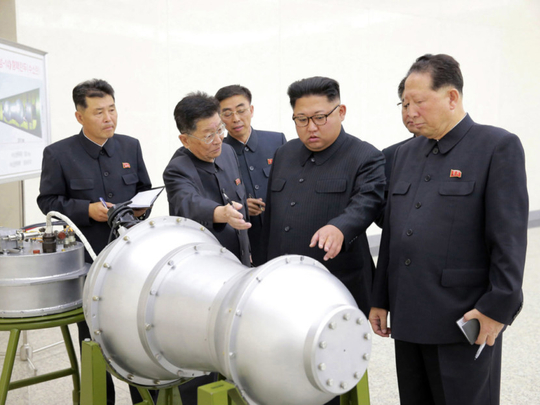
John Brennan, the former head of the CIA, estimates the chance of a war with North Korea at 20 to 25 per cent.
Joel S. Wit, a Korea expert at Johns Hopkins University, puts it at 40 per cent. Richard Haass, the president of the Council on Foreign Relations, says the odds may be somewhere around 50-50.
Yet, we’re complacent: Neither the public nor the financial markets appreciate how high the risk is of a war, and how devastating it could be.
The Congressional Research Service in the United States last month estimated that as many as 300,000 people could die in the first few days of war — and that’s if it remains non-nuclear. If there is a nuclear exchange, “there easily could be a million deaths on the first day”, says Scott Sagan, an international security expert at Stanford.
Sagan says the odds of war “are certainly greater than is widely recognised by the American public”.
US President Donald Trump is in Asia this week, rallying countries to strengthen sanctions against North Korea. His past efforts at this have been quite successful, and during my recent visit to Pyongyang, I saw signs that sanctions were biting.
But the goal appears doomed: Almost no expert believes that sanctions will force Kim Jong-un to give up his nuclear weapons or halt his missile programme. That puts us on a collision course, for North Korea seems determined to develop a clear capacity to target the US with nuclear weapons, while the White House hints that it would rather have a war than allow the North to become a nuclear threat. “Our president has been really clear about this,” H.R. McMaster, Trump’s National Security Adviser, said on Fox News. “He is not going to permit this rogue regime, Kim Jong-un, to threaten the United States with a nuclear weapon. And so he is willing to do anything necessary to prevent that from happening.”
The whispers in Washington are that “anything necessary” includes air strikes on North Korea, such as a strike on a missile as it is being prepared for launch. When I asked North Korean officials what would happen in those circumstances, they answered unambiguously: War. Tammy Duckworth, a former military pilot who is now a Democratic senator from Illinois, says that from what she hears, the chance is greater than 50-50 that the president will order a strike. “I see a change in posture,” she told me. “I am extremely worried that we’ve moved beyond ‘Let’s prevent war’ to ‘It’s acceptable to do a first strike’.”
Duckworth and other Senate Democrats have introduced legislation that would prevent the president from making a pre-emptive strike on North Korea without congressional approval, barring an imminent threat to the US or its allies.
Senator Lindsey Graham (Republican, from South Carolina) has said that Trump told him he’d choose a war with North Korea over allowing it to continue on its course. “There is a military option: To destroy North Korea’s programme and North Korea itself,” Graham told the Today show, relaying a conversation with Trump. “If thousands die, they’re going to die over there. They’re not going to die here — and he’s told me that to my face.”
Graham said that if North Korea continues to test intercontinental ballistic missiles, a war is “inevitable”. This may be a bluff, but, if not, war is coming, for almost every expert believes that North Korea will continue its testing.
Trump didn’t create the problem, and it’s real: We should fear North Korea gaining the capacity to destroy US cities. Eerily, on my last visit, North Koreans repeatedly said that a nuclear war with the US was not only survivable but winnable.
The US must now choose among three awful options: 1) A “freeze for a freeze” deal, which US Secretary of State Rex Tillerson seems to be pursuing; 2) Long-term deterrence, just as America has deterred North Korea for decades from using its chemical and biological weapons; 3) A conventional war that might escalate into a nuclear exchange.
Security experts overwhelmingly say the least terrible choice is the deal for a freeze on North Korean testing in exchange for reductions in sanctions or US-South Korean military exercises, but at this point it’s not clear that either Washington or Pyongyang would agree to such an arrangement. Deterrence is next best, and war is the worst option. But that’s the option Trump seems headed toward.
North Korea may also inflame the situation with provocations at any time, such as firing a long-range missile into the sea near Guam, or conducting an atmospheric nuclear test that would send radioactive fallout drifting towards the United States. Trump may also shoot down a North Korean missile over international waters; that’s less provocative than a strike on North Korean territory, but I’d still expect a military response. And there’s a constant risk of miscalculations and incidents that spiral out of control.
Fourteen years ago, America stumbled into a devastating war with Iraq without thinking through the consequences. This feels like deja vu — only potentially far more devastating. “I do believe there’s a greater risk than people appreciate,” Haass told me. “I don’t know if the odds are 50 per cent, 40 per cent, 60 per cent, but it’s a hell of a lot more than negligible.”
— New York Times News Service
Nicholas Kristof is an American journalist, author and a winner of two Pulitzer Prizes.










